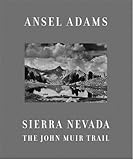John Muir Trail: The Man and the Trail that was Named after Him
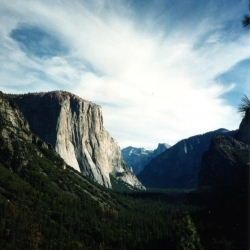
Honoring the Man Who Helped Usher in Conservation
Some places are only available to us for brief amounts of time. The John Muir Trail is one of those places. Open for four short months a year, it is the ultimate Summer camping and hiking adventure.
Before arthritis, we went camping several times a year. I remember having a co-worker who often went out on backpacking trips. I wondered what it would be like to set off for 2 days or a week and spend it in the back country with nothing to listen to but the rushing water of streams and bird song. I was enticing.
The first time I visited Yosemite National Park I fell in love with John Muir. I read his book My First Summer in the Sierra's which he wrote in 1911, and begin to dream of setting off on a hiking trip into the Sierra Nevada Mountains.
I had read up on the John Muir Trail named in his honor and it sounded amazing. I thought that it would be incredible to hike it or at least part of it. Summer vacation would never be the same!
[Photo of Yosemite National Park Copyright Melody Lassalle - All Rights Reserved. No reprints without permission.]
When we try to pick out anything by itself, we find it hitched to everything else in the universe.
— John MuirMuir and the Waterfall
Muir loved being in Yosemite Valley. But, he really loved being at the top of Yosemite Falls.
In one of his works, he wrote about how he would take his bedroll and blanket, climb to the top of the waterfall, then pitch his camp for the night.
Muir loved the sound of the water crashing belong and nothing but the stars above him.
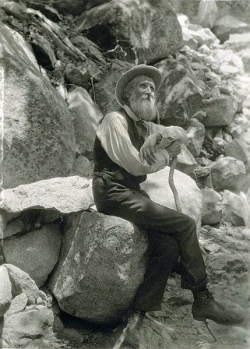
Who was John Muir?
And, why'd he get a trail?
John Muir was born in 1838 in Dunbar, East Lothian, Scotland, to Daniel Muir and Ann Gilrye. His family immigrated to the US in 1849. His father founded Fountain Lake Farm in Portage, Wisconsin.
Muir studied at the University of Wisconsin--Madison. He took a variety of courses over several years, but never graduated. He had a strong background in geology which helped him with his later pursuits.
In 1864, he left for Canada to avoid the military draft. He returned to the US a couple of years later and worked in engineering. After a work related accident nearly left him blind, he decide to follow his heart and pursue his love for plants. He became a naturalist and walked from Indiana to Florida studying every living thing along the way.
Illness would interfere with his plans to explore South America. He contracted malaria in Florida.. Instead of heading towards South America, he veered off to California. That it when Muir found his beloved Yosemite. Though he had read about the place, he wasn't fully prepared for its grandeur. This is how Muir described Yosemite: "No temple made with hands can compare with Yosemite... The grandest of all special temples of Nature."
These were not easy years for Muir. He was poor and unemployed. He did some sheep herding and lived off the land. He studied the natural environment of Yosemite, sifting through it's wonders big and small. His theory on how glaciers shaped the mountainous region added to our scientific understanding of the Sierras. He wrote volumes about his experiences which fascinated the rest of the nation and drew people to the area.
Throughout his life he wore many hats as an engineer, geologist, botanist, naturalist, writer, and conservationist. He left behind 12 books, hundreds of writing, and the birth of the conservation movement. His legacy can be seen all across America with each National Park and wilderness area that has been preserved.
Exploring the Trail
The John Muir Trail is really a series of several hikes. Some can be done in a day, others are meant to be done overnight or over a week. Many have walked the whole thing from end to end.
There are differences in the trail. Some parts are grueling and should not be attempted by an inexperienced hiker. Other parts are more for the casual hiker who goes outdoors for the family vacation each year.
If you are planning on taking this adventure you need plan out which sections you'll do, where you will start, and where you will finish. A good guide book based on this trail can help you define the parameters of your trip.
He Helped Start the American Conservation Movement
Muir's greatest contribution may be his conservation work. He had spent so much time in Yosemite and the surrounding area. He realized the dangers of leaving it unprotected. He understood that livestock, logging, and humans would eventually destroy much of the beauty. Thus, he was inspired to save it for future generations. He co-founded the Sierra Club in 1892 and kicked off a new era of conservation and preservation.
Yosemite was named a national park in 1890, but control was under the State of California. Muir pushed for federal preservation enlisting the help of Theodore Roosevelt by inviting him to the park in 1903. In 1906, Roosevelt signed legislation that took control of Yosemite Valley and Mariposa Grove from California's control, but not the entire region. Muir fought vigorously against the project to dam Hetch Hetchy Valley, also known as Little Yosemite Valley. It was a battle that he lost.
Muir continued to fight for full protection of the park. Though he didn't succeed in his lifetime, it happened soon after. In 1916, the National Park Service was created and Yosemite was placed under it's jurisdiction.
Muir died in 1914 at the age of 76. A year later Woodrow Wilson signed the act that created the Hetch Hetchy Dam.
What do you need for this trip?
Think you're ready for this backpacking trip? Unless you're doing the easier day trails, you're going to need to be prepared. John Amorosano gives a detailed look into all the equipment he needed for this endeavor.
This half hour video walks you through the necessary equipment for this challenge.
Have you ever gone on an overnight or multiple day hiking trip?
And I would walk 100 miles - ...or not
I've always wanted to do a multiple day hiking trip. Unfortunately, with my disability hiking means walking around the block.
Maybe some day they'll come up with a viable solution to the missing cartilege in my feet and I'll get my chance. I'd like to dream of those Sierra Nevada mountains and some day making like John Muir and seeing them all.
It All Starts at Yosemite - Awe inspiring from start to finish
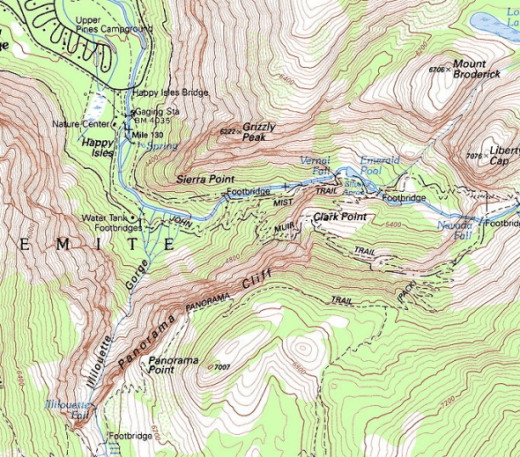
A Few Details...
- The trails is 211 miles long.
- It passes through the Ansel Adams Wilderness Area, Devils Postpile National Monument, and Sequoia National Forest.
- The lowest point is at Happy Isles (4,035 feet) and the highest is at Mt. Whitney (14,496 feet)
- It takes about a month to travel through all seven segments.
- Construction of the trail began in 1915 as a joint venture of the State of California and the Sierra Club. The Depression slowed progress, but the trail was finally completed in 1938.
- The trail can be hiked from June to September.
If you've ever visited the valley in Yosemite National Park, then you've probably tripped over the start of this trail. That's because it all begins at the Happy Isles trail head which is in the heart of the valley on the way to Mirror Lake. This part of the trail leads one out of the valley and up through Tuolumne Meadows. After Tuolumne Meadows, it winds its way out of the park into the Ansel Adams Wilderness.
Like most visitors to Yosemite, I've done bits and pieces of the John Muir Trail without even knowing it. I've been all through Happy Isles. I've hiked the portion to Vernal and Nevada Falls. I've seen the view from Glacier Point. And, I've done some walking around Tuolumne Meadows.
The views at the beginning are spectacular. You could call it a day after visiting any of those points of interest. But, it's only a taste of the 211 mile trail to Mt. Whitney. This trip will give you one amazing view after another. I've been in different parts of the Sierra Nevada Mountain Range. Its beauty is hard to match.
In every walk with nature one receives far more than he seeks.
— John MuirThree Places I'd Like to See
How did I narrow it down to three?
The John Muir Trail passes through so much beautiful landscape. It starts at Yosemite National Park. Then it heads through the Ansel Adams Wilderness Area. The next stop is Devils Postpile National Park and then on to the John Muir Wilderness Area. From there it heads through King Canyon National Park. Finally, it ends at Sequoia National Park.
I had a tough time choosing, but I've narrowed it down to three points I would love to see if I ever had the chance. Maybe some day that cure for arthritis will come, science will make me some fake cartilage, and I'll be on my way!
No one does it like Ansel Adams
Ansel Adams made his name photographing Yosemite and the surrounding area. His black and white photographs are iconic. And, you really can't think Yosemite without bringing to mind his work.
This book is a collection of his photographs of the John Muir Trail.
Devils Postpile National Monument - A Geological Wonder
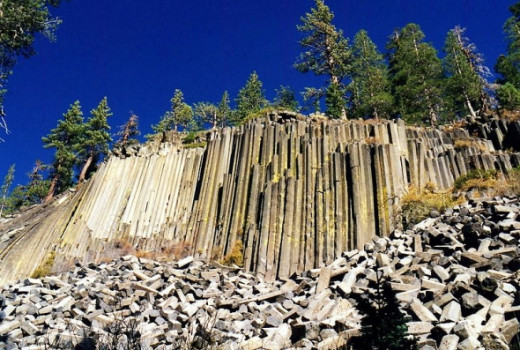
I don't know why but I'm intrigued by Devils Postpile National Park. You have the oddly formed rock formations all stacked neatly together. They are called columnar basalt. They are 60 feet high and symmetrical. The columns were formed by lava over 100,000 years ago. It's a rarity within the geological realm.
There's also the 101 foot high Rainbow Falls. It got it's name from the many rainbows that appear in it's mist. And, of course, there are the snow capped mountains framing lakes.
Lake Virginia - Mountain lake beauty
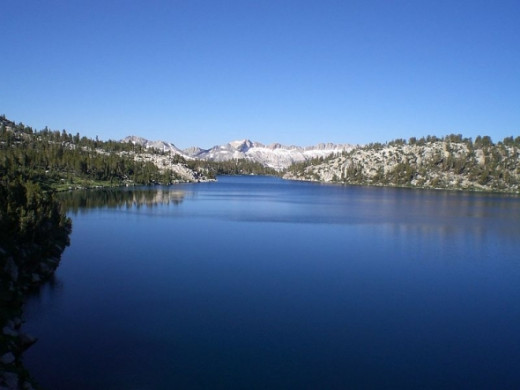
I think the photo says it all. Virginia Lake is one of those beautiful Sierra Nevada lakes with crystal clear blue water surrounded by mountains and Jeffrey Pine trees. The lake is located in Fresno County and falls within the John Muir Wilderness Area. The elevation at the lake is 10,300 feet.
It looks serene, doesn't it?
Everybody needs beauty as well as bread, places to play in and pray in, where nature may heal and give strength to body and soul.
— John MuirThe Great Western Divide - Mountains at the end of the trail
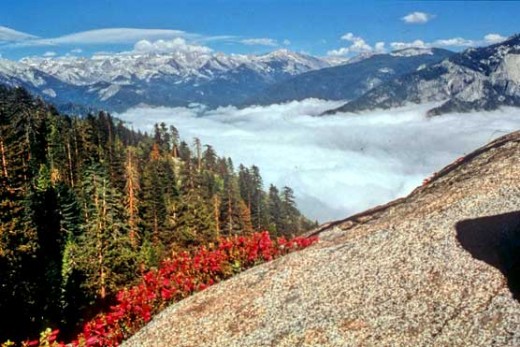
The Great Western Divide is part of Sequoia National Park. It is one of the most spectacular panoramic views in California, outside of Yosemite's Glacier Point view.
Their are several peaks in this range. The highest is Mount Kaweah. It's 13,802 feet in elevation. Just beyond this range is the end of the trail and Mt. Whitney.
Do you know John Muir?
view quiz statisticsDo it in a day!
Not up for spending the month of July trekking through the mountains? I can understand that. You'd have to get all that time off to begin with. Then, there are other considerations like the equipment needed for such a trip. It's costly to buy backpacking and camping equipment for a long hike.
Then, you'd be out there at night with the bears, mountain lions, raccoons, and who knows what other creatures. I don't mind so much in the daytime, but the forest is awfully noisy at night. I probably wouldn't be able to sleep with all that chatter freaking me out.
There are several parts of the trail that you can do in a day. The splendors are waiting for you any time during the summer months. This guide outlines the many day trips ready and waiting to be enjoyed.
Thanks for visiting this page! Did you know about the John Muir Trail before reading this? Have you hiked any part of it? What would be your dream vacation?


